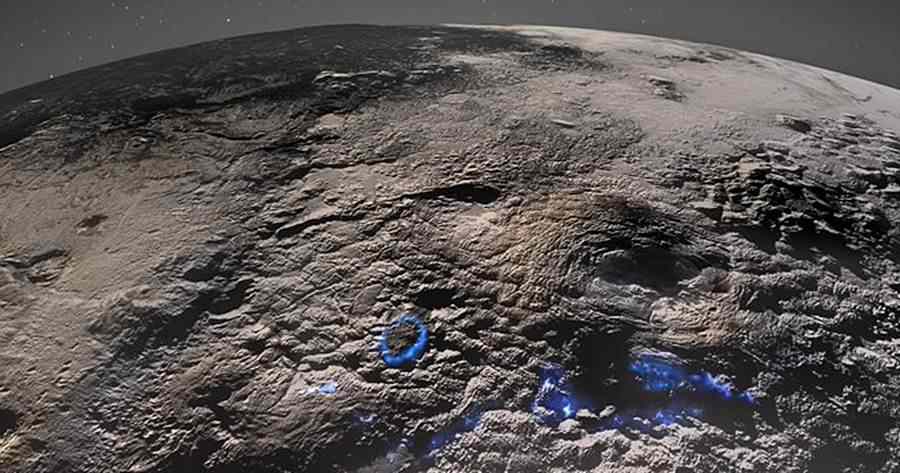![]() A perspective view of Pluto’s icy volcanic region. The surface and atmospheric hazes of Pluto are shown here in greyscale, with an artistic interpretation of how past volcanic processes may have operated superimposed in blue. (Isaac Herrera/Kelsi Singer/NASA/Johns Hopkins University Applied Physics Laboratory/Southwest Research Institute/)
A perspective view of Pluto’s icy volcanic region. The surface and atmospheric hazes of Pluto are shown here in greyscale, with an artistic interpretation of how past volcanic processes may have operated superimposed in blue. (Isaac Herrera/Kelsi Singer/NASA/Johns Hopkins University Applied Physics Laboratory/Southwest Research Institute/)
___________________________________________________________________________________________________________________________________________
Wed 30 March 2022:
Pluto had been cloaked in mystery since its discovery in 1930, when it was previously considered the ninth planet in our solar system before being demoted to a dwarf planet in 2006. The curtain has been drawn back owing to NASA’s ambitious New Horizons flyby in 2015, and astronomers are continuing to show that Pluto is much more interesting than previously assumed.
A group of dome-shaped ice volcanoes that appear unlike anything else known in our solar system and may still be active have been spotted on Pluto. This discovery was made using data from NASA’s New Horizons mission, and it indicates that this remote frozen world is more dynamic than previously thought.
/https://tf-cmsv2-smithsonianmag-media.s3.amazonaws.com/filer/18/8f/188f9b2b-17d3-4a83-b6ff-a7a74dd47973/nh-pluto_crop.jpg)
According to scientists, the cryovolcanoes, which may number ten or more, range in height from six-tenths of a mile (1 km) to four and a half miles (7 km). Unlike Earth volcanoes, which spew gases and molten rock, the cryovolcanoes on this dwarf planet extrude vast amounts of ice – likely frozen water rather than some other frozen material – with the consistency of toothpaste, according to the researchers.
Cryovolcanoes have been also been identified on the asteroid belt dwarf planet Ceres, Saturn’s moons Enceladus and Titan, Jupiter’s moon Europa, and Neptune’s moon Triton. However, their surface parameters, including temperature and atmospheric pressure, as well as diverse combinations of ice elements, all differ from Pluto’s, according to the researchers.
NASA: el impresionante vuelo rasante sobre Plutón y Caronte con las mejores imágenes del paso de la nave New Horizons
— AstroAventura (@AstroAventura) March 27, 2022
“Finding these features does indicate that Pluto is more active, or geologically alive, than we previously thought it would be,” said lead author and planetary scientist Kelsi Singer of the Southwest Research Institute in Boulder, Colorado.
“The combination of these features being geologically recent, covering a vast area and most likely being made of water ice is surprising because it requires more internal heat than we thought Pluto would have at this stage of its history,” Singer added.
Pluto, which is smaller than Earth’s moon and has a diameter of about 1,400 miles (2,380 kilometres), circles the sun at a distance of around 3.6 billion miles (5.8 billion kilometres), roughly 40 times that of Earth. Plains, mountains, craters, and valleys can be found on its surface.
From possible ice volcanoes to twirling moons, @NASANewHorizons reveals more about Pluto https://t.co/vQ21VIxJJ0 pic.twitter.com/OUWONLTCPI
— NASA (@NASA) November 9, 2015
The latest study’s images and data, which were retrieved by New Horizons in 2015, confirmed prior assumptions concerning cryovolcanism on Pluto.
According to Southwest Research Institute planetary scientist Alan Stern, the New Horizons principal investigator and research co-author, the study discovered not just widespread evidence for cryovolcanism, but also that it has been long-lived, and not a mere singular event.
What’s most fascinating about Pluto is that it’s so complicated – as complex as Earth or Mars despite its smaller size and greater distance from Sun, said Stern.
Pluto, like Earth and the other planets in our solar system, formed around 4.5 billion years ago. It appears that its cryovolcanoes are quite new, having formed in the last few hundred million years, based on the lack of impact craters that would ordinarily collect over time.
On a geologic timeline, that’s quite recent said Singer, adding that because there are so few impact craters, it’s plausible that these processes are still going on now.
Singer said that to some degree Pluto is still somewhat of a mystery, and there are still many questions she’d like to see answered. The images sent back account for roughly 40 per cent of the dwarf planet as a whole. And seeing more of Pluto might reveal more of these regions, which in turn would help astronomers determine how much heat might be needed to create these cryovolcanoes.
Singer says she is eager to reveal more about this distant world. It would help astronomers understand more about own solar system and its origins, not to mention the myriad moons that lie out in the outer regions.
“Pluto’s unique in its environment. It’s unique in its distance,” Singer said. “And it’s not what we expected. So it really just kind of makes us have to say: what are we missing in our models? And unfortunately, we don’t have all the answers there.”
NEWS AGENCIES
___________________________________________________________________________________________________________________________________________
FOLLOW INDEPENDENT PRESS:
TWITTER (CLICK HERE)
https://twitter.com/IpIndependent
FACEBOOK (CLICK HERE)
https://web.facebook.com/ipindependent
Think your friends would be interested? Share this story!





